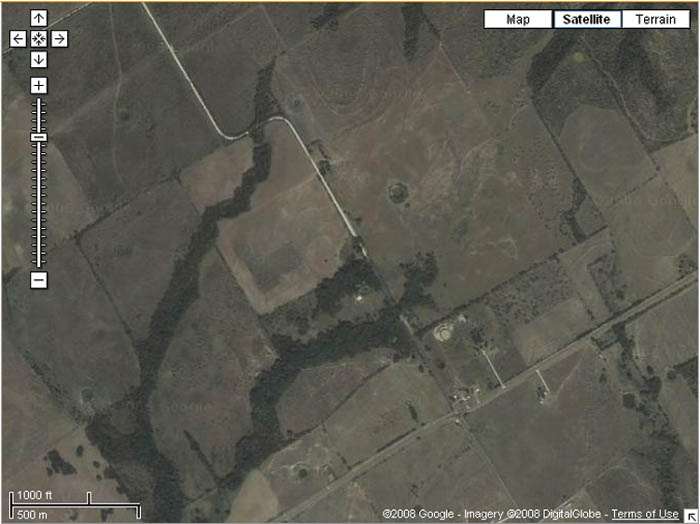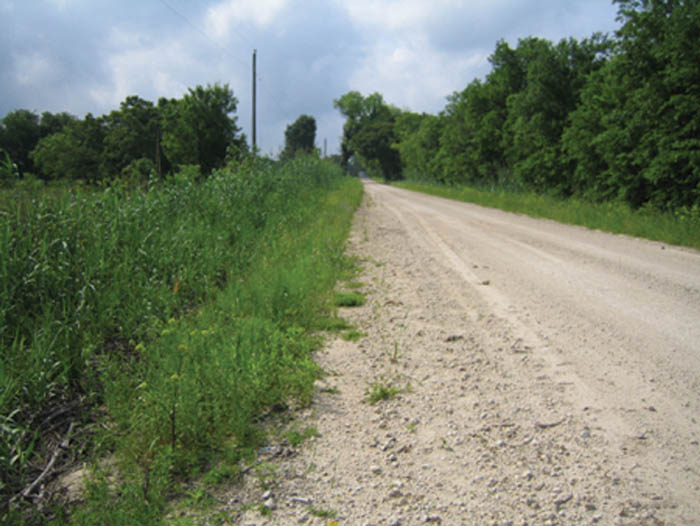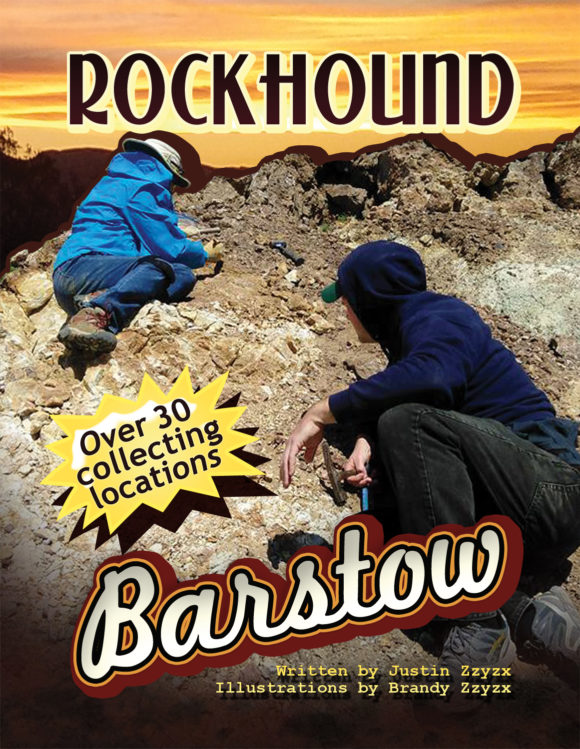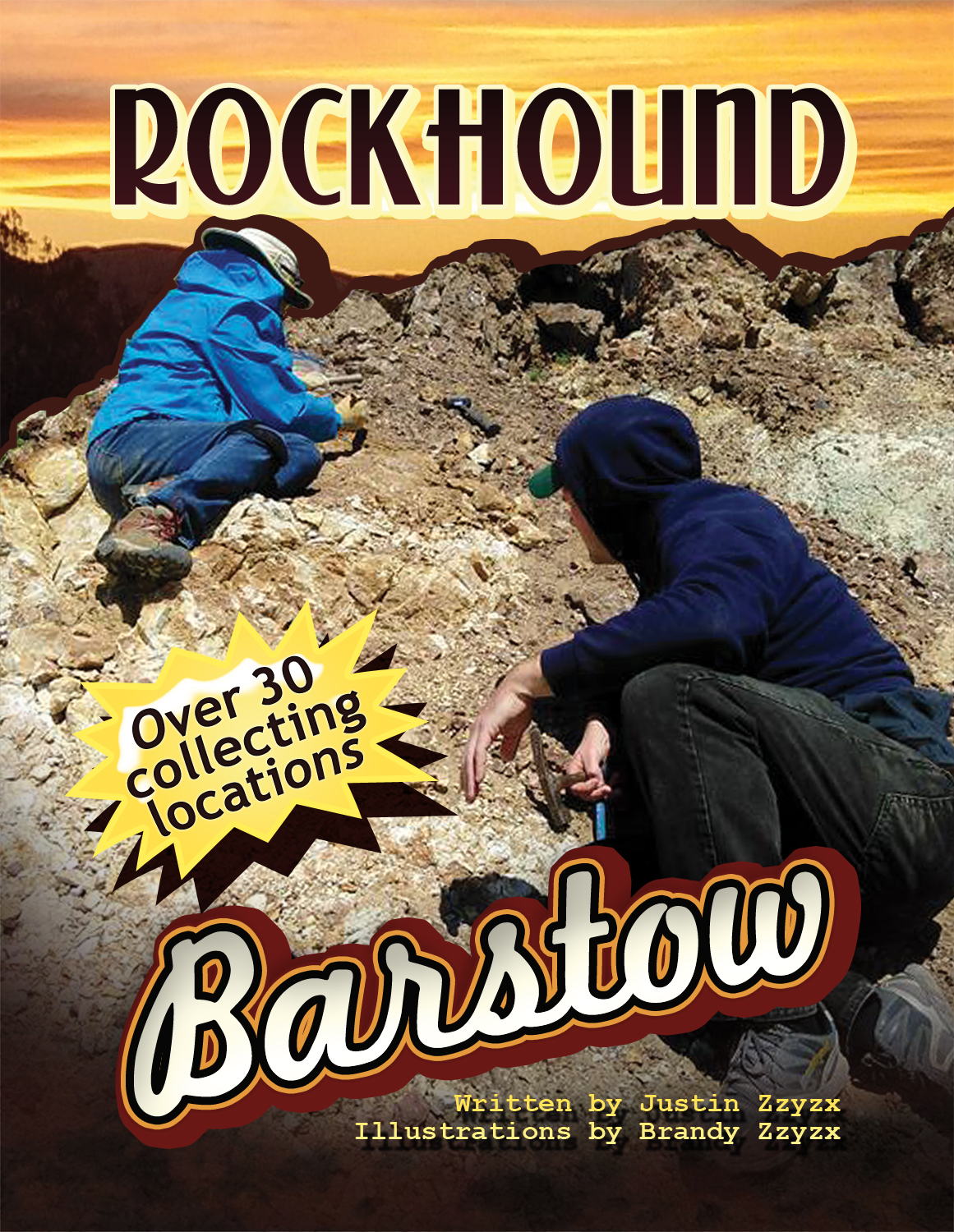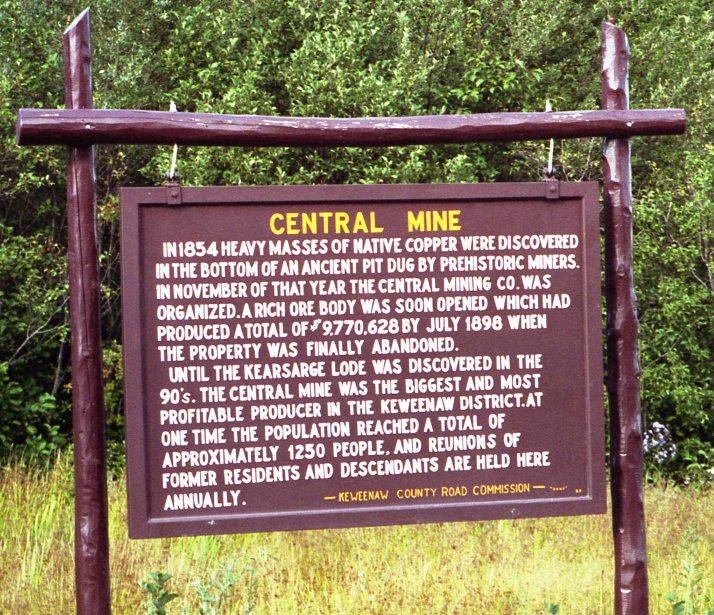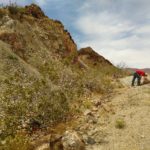
Written by Justin Zzyzx – Author of “Rockhound Barstow”
This location and many others are featured in the field guide – Click here to buy a copy for yourself
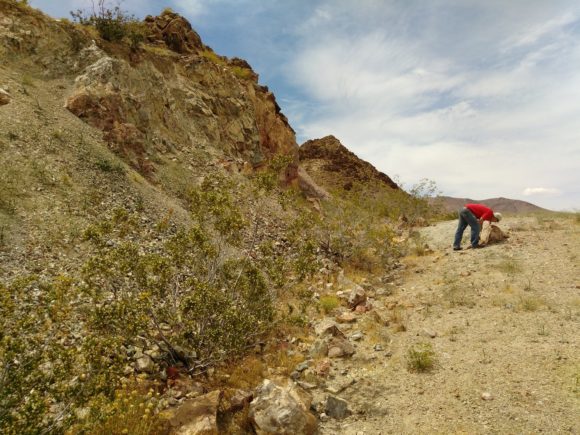
Justin Zzyzx inspecting boulders at the Noble Prospect.
I just love exploring the nooks and crannies of the hills and mountains around Barstow California. The area around here is known for the beautiful geological formations all around, such as Rainbow Ridge, as well as the silver mines of Calico, once a silver boom town, now a commercial tourist attraction. Barstow, a perfect place to set up base and explore the Cady Mountains, Afton Canyon, Opal Mountain, Mule Canyon, Alvord Mountain, Yermo’s rolling hills of alluvial agates and jaspers and so much more. There is a veritable treasure chest of mineral adventures to be had in these colorful hills, visiting is a thrill, and I, as a resident, love to take full advantages of these rock deposits.
As a frequent leader of field trips and author of the “Rockhound Barstow” field guide, I’m always looking for new places to take people to collect interesting minerals and lapidary materials. My personal favorite is finding places where there are both nice crystallized minerals, as well as colorful lapidary material, that way, out of the dozens of rockhounds who have joined me over the past year on each monthly field trip, everybody is happy with what they can find. Exploring mining information on MRDS.org, I noticed several mines located in the Northern parts of the Calico mountains. I could see, just 10 miles away from my pistachio grove I call home in Newberry Springs, there was a Wollastonite mine, a Nickel mine and an Arsenic mine, all bunched up to the West of Coyote Dry Lake.
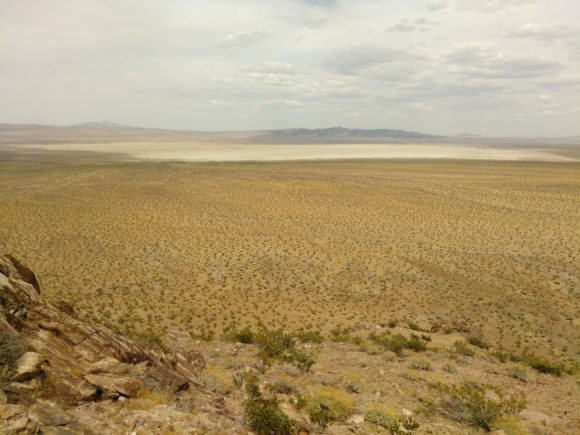
View looking out to Coyote Dry Lake from the un-named Nickel deposit
On our first outing to this string of locations we tried to access it from the East, coming up Coyote Dry Lake road. The dry lake was not as dry as we expected, in fact, it was quite moist and with no desire to go “muddin”, we turned back and tried the other way into the area, all the way around the Fort Irwin road passage, 20 miles to the West. Fort Irwin road is a VERY busy two-three lane road that connects Fort Irwin to Barstow and highway 15. Fort Irwin, a large Marine base, requires a large amount of workers from the Barstow area to work the service industry jobs, as well as the tech jobs, along with all the contractors, you can imagine this is a very busy road. We drove through the pass on the West side, looking at all the remains from the silver mines that made the Calico district what it was and what it is today. The ore was mostly chloragyrite, a silver mineral that is toxic to process, proving to be costly and environmentally unsound, so, the silver mines stand dormant, forever.
Entering on Madrugador road, Eastbound from Fort Irwin road, you pass by a Wollastonite deposit to the North, which we inspected with little of interest to be found, then, continuing along on this fairly smooth, slightly rocky road we turned off to the Northeast on a power line road which then takes us directly to the Wolly Wollastonite #5 deposit, a long abandoned deposit of this interesting white mineral. Some field guides have published this location, however, they always refer to it as an Onyx deposit. Onyx, a name for Calcite, is found at lots of places around the Calico mountains, however, at this deposit, there is only the non-stop white bliss of massive Wollastonite.
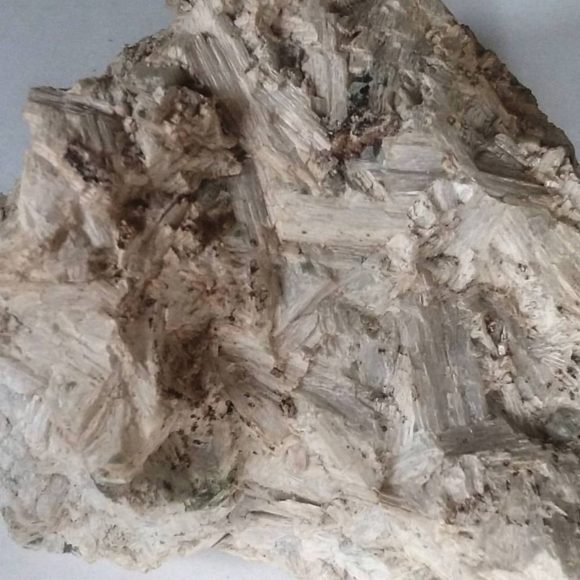
Long fiber Wollastonite crystals on the surface of massive Wollastonite
Wollastonite is a mineral that can be found as part of a Skarn deposit. Common related minerals are Grossular Garnet, Calcite, Quartz, Hedenburgite, and Epidote. The grains of the skarn deposits can be quite dense, leading to amazingly hard stones that can be worked into lapidary objects like vases and pillars. The wollastonite here was most likely mined for use in the pottery industry. Wollastonite, CaSiO3, a Calcium Silica Oxygen mineral that often has impurities of iron, manganese and magnesium, all elements found in abundance across this mountain range. Crushed, this powdered rock would be used for adding to clay, reducing cracking when ceramics are fired in a kiln, as well as added to paint base, a filler to make paint thicker.
At the Wolly Wollastonite deposit we would find tons of massive white wollastonite with the choice mineral specimens being the small bits and thin plates of acicular “long fiber” wollastonite crystals, which form flat on the surface of the rocks and boulders. Along with these, a bit of orange Grossular garnet can be found forming in the sharp borders between the wollastonite and the county rock. Finding larger pieces of this material is uncommon, but possible, however bits of wollastonite with thin areas of garnet are fairly common along the waste rock piles. In the quarried areas, along the rock wall, you can see several veins of garnet, but, in my opinion, they are not terribly thrilling. One thing is for sure, the guides that have continuously pegged this as an Onyx deposit can now be corrected in the next printing! The deposit takes up the Northern side of this far outlying mountain, spilling out of the most Northern part of the Calico mountains. Various bits and smears of other minerals have been spotted, like epidote and hedenburgite, so with further exploration you might uncover something interesting.
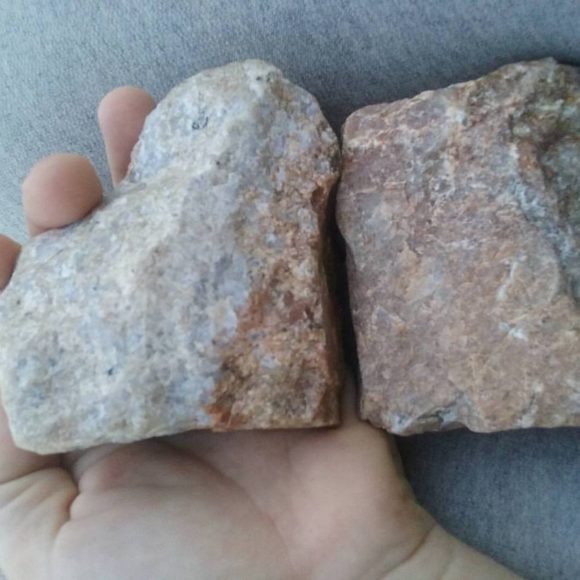
Spessartine garnet masses found in conjunction with the wollastonite deposits of the North Calico Mountains
A few months before I decided to visit this Wollastonite deposit, I was told by a gold miner in the Hesperia area that there was a Wollastonite deposit up in the North Calico mountains that had terminated grossular garnets. Wollastonite forms as a part of skarn deposits. One of the best mineral deposits in these formations are calcite pods with glossy grossular garnets underneath. Locations around the world produce specimens like this, the calcite acts as a blanket for the garnets, protecting them from any harm, until we, rockhounds, remove them from the ground and soak them in acid to dissolve the calcite and reveal the beautiful garnets underneath. While massive garnet is found at the Wolly Wollastonite deposit, the lack of calcite pods at this and every other Wollastonite deposit I’ve visited has turned up fruitless. Yet, chasing this lead has brought me to explore some infrequently visited areas of the rocky desert hillsides.
Going back in reverse from the Wollastonite deposit, you can head South in the first turn, which is a wash that leads up to the solid hillside and upwards on a road that leads to a former Nickel deposit, resting on this craggy spire, a semi steep climb leads to a non-connecting circular road around the peak. From here you have spectacular views of the valley below, the vast white/tan of Coyote Dry Lake, the Coptic monistary, and hey, I can even see my house from up here! Looking at this location from the comfort of my home, with my imported mine marker data from MRDS, I could see this Nickel mine and also find out more information about it. It referenced a mention in a a Southern Pacific Railroad booklet on Mineral of Industry, Volume 3, which mentions the deposit geology as “niccolite, arsenopyrite, annabergite, and uvarovite in a verticle silicic dike that strikes NE along a shear zone in hornfels and quartzite.”
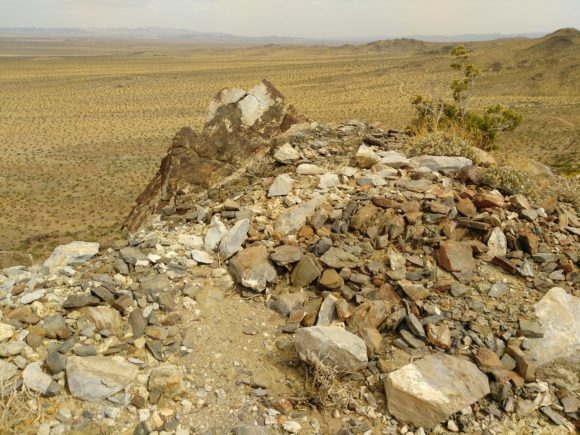
View from on top of un-named Nickel deposit
Off we went, to go visit the un-named nickel deposit. The wind on our first visit makes the location very memorable. We can have wind gusts over 65 miles an hour on some days around these parts and that day the wind was so forceful we were quite worried we would be swept off the mountain. Maintaining a tight foothold, we explored the area, looking for bright green crystals of annabergite and chrome green uvarovite garnets. Instead, we found the meaning of “silicic dike”! All of the minerals we have found at this location have been frozen in blocks of silica. While this does not do anything for us mineral collectors, it makes for a unique lapidary material. The same stuff as the classic German “Nickel Quartz”, this green stone takes a nice polish and the contrast of white and green makes for an interesting stone. Floating around in this silica, tiny bits of chrome green uvarovite garnet are found, while nothing to write home about, they do add a little something to some of the slabs and tumbled stones we produced out of this ore. If there were crystals here, this could be one of my favorite locations, but even in massive lapidary form, this in a rare treat in terms of mineralogy, a geat view-point in this area of the North Calico mountains and yet, just one of many locations in a short distance in this mountain range.
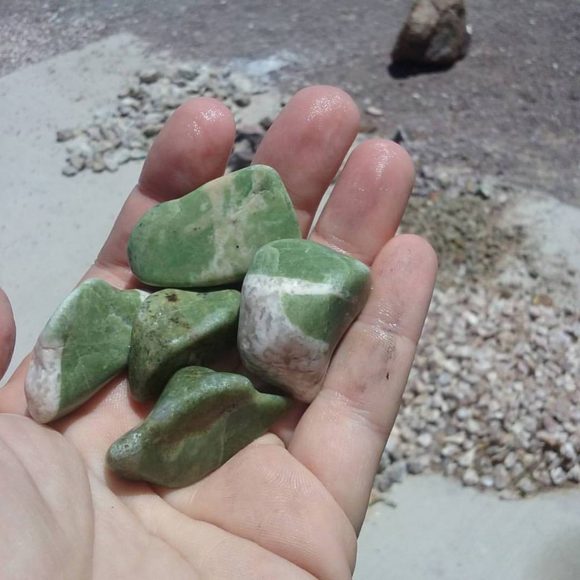
Tumbled nickel quartz from the un-named Nickel deposit
Just off to the Southwest, the road takes you to the Puerto Negro mine, a series of rock dumps that stop at a mine entrance a few hundred yards south of the beginning of the dumps. This is an Arsenic mine that produced an arsenic rich ore with the occasional bit of calcite and realgar. While I have not found many specimens at this location, the few I have found have been quite uncommon, orangy red realgar in layered clear calcite crystals. Drive North to connect back with the power line road and drive over to the next canyon to the South, taking Madrugador Road, home to several prospects for copper and gold, before heading back out to Fort Irwin Road. These gold deposits do not have much in the way of collectables for mineral or lapidary enthusiasts, however, they do produce chunks of calcite and masses of red, iron stained, quartz.
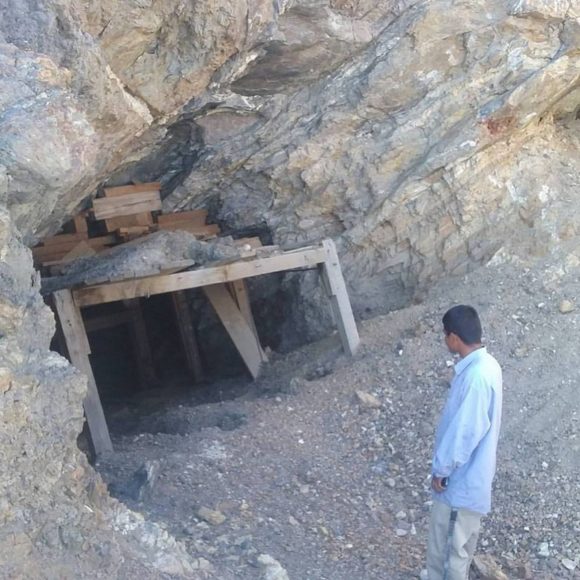
Entrance to the Arsenic Mine, the Puerto Negro
From here, it is time to go across Ft. Irwin Road, just a few hundred yards to the South, a road stretches out towards the Northwest, reaching out to several locations were crystals and lapidary materials can be found. The road is a very nice, mostly smooth flat desert dirt road. There are a couple tiny washed out areas, but most any passenger car can navigate the area. Immediately to the North, a small set of ridges spread out, the ridge to the West of the hills contains two locations to explore. A massive Barite locality called the Ball mine and a funky Wollastonite deposit with some odd rocks to be found. You pull off this new dirt road and into a wash road that loops around, park here and hike into the mountain valley to find the Ball mine, which is easy to see and high up on the hillside.
The Ball mine was a series of tunnels and surface workings that produced massive white barite, which can be found in abundance as lumps of heavy white rock. While unassuming, when exposed to UV light, these lumps glow a pleasing green and pink. There are tons and tons of this material laying around the mine adits, so you will have plenty to choose from. Continuing North into the canyon you will come across a Wollastonite deposit that has bits of calcite and some black rock that is said to be chromium bearing.
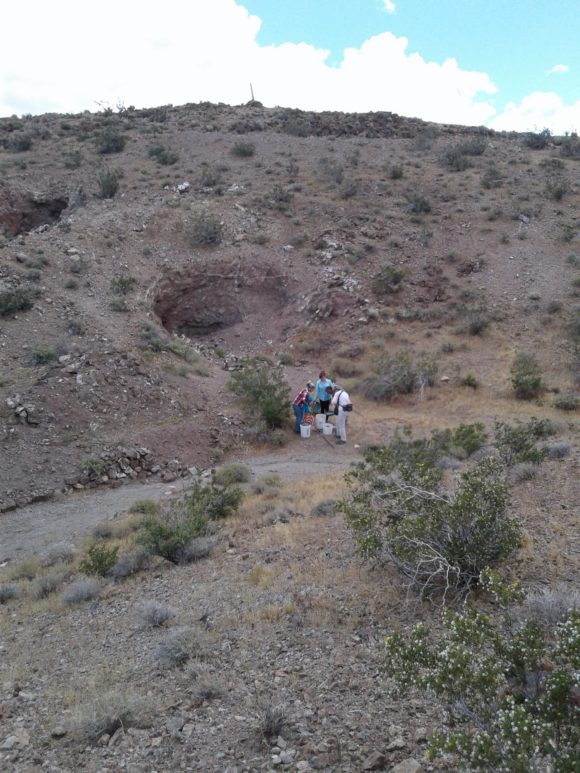
Rockhounds collecting Garnets at the Nobel Prospect
Back on the main dirt road, you continue Northwest for a mile or so until you come across a faint road headed South which leads to a large pile of rocks in the middle of the flat desert. It is unusual to see a pile of rocks such as this, however, this outcropping of rock is a happy accident for all of us. Here you can find a great deposit of Onyx, a flowing series of banded tans and yellows, along with bright red caused by iron impurities, along with areas of quartz, in the center of the stones as well as on the surface. Druzy specimens of quartz and calcite can be found, the only drawback is the size of the matrix they are sometimes attached to! The large chunks of stone cut to reveal beautiful patterns, while being nice and crack free, solid cutting material. It is remarkably easy to find, within a half hour at the location, cutting material to keep you occupied for days and weeks.
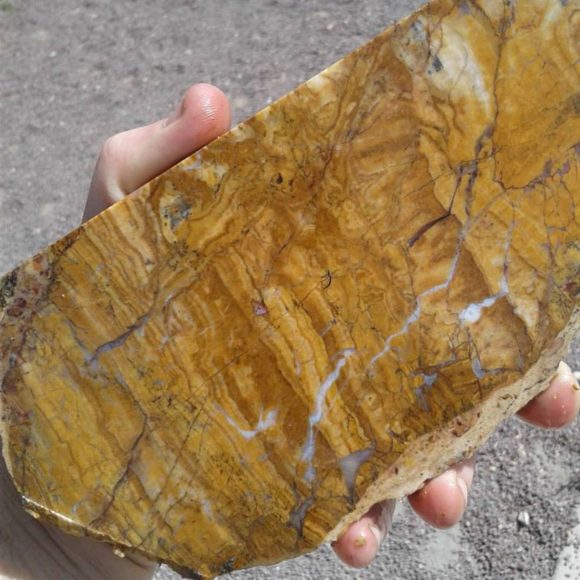
Sliced Travertine from the large travertine outcrop in the North Calico Mountains
Traveling only another thousand yards to the West along the main dirt road, you come across the Noble prospect, a mineralized zone consisting of a short canyon wash to the East, with short adits that pushed out garnets, quartz, epidote and calcite. While we were hoping for garnets trapped inside calcite pods, these garnets are frozen in a quartz matrix, an while crystals can get up to an inch across in size, there is no way to free them from the host rock. Still, terminated garnets can be found in this area and the masses of quartz, epidote and garnet make for interesting lapidary materials. Just a short distance from this wash, a road takes you a few hundred feet to a bench in the mountainside, filled with boulders containing calcite crystals and quartz druzy, the druzy areas measuring up to and over one foot in size on several of the boulders. The trick is to find specimens that are small enough to take home. Several pieces showed evidence of layers of quartz covering and replacing the calcite crystals, which make for very interesting mineral specimens.
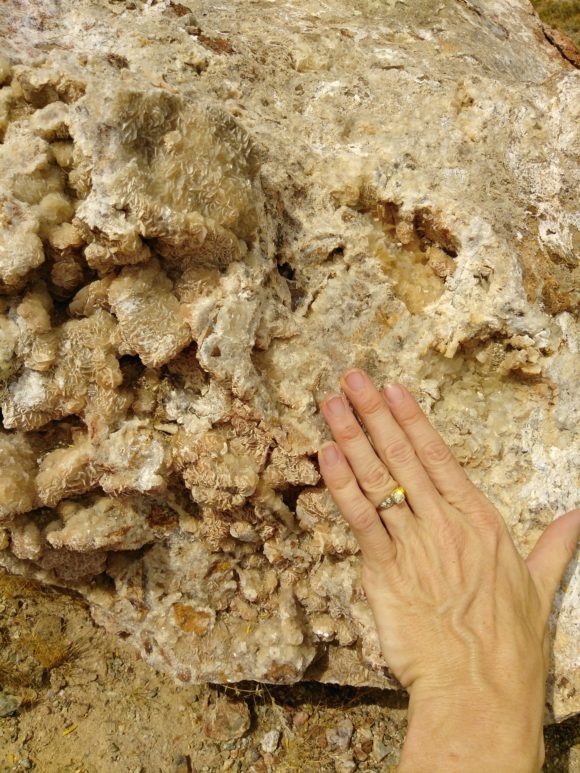
At the Noble Prospect, Boulders of Calcite with Crystals growing in vugs can be found.
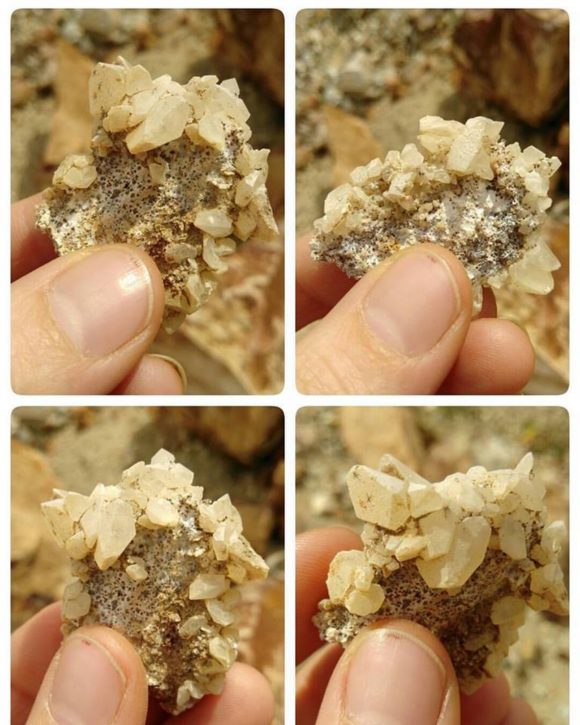
Calcite crystals plucked from the walls of the Noble Propsect.
If you like this article, check out the 28 page full color field guide “Rockhound Barstow” for sale online at the following links
Buy it on eBay
Order it on Amazon, or Buy it for Kindle eBook Readers
Or, hey, here is the map…
![]()
Related posts:
Field Trip: Midwestern Geode Localities
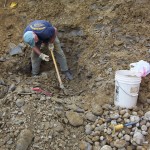
By: Jeremy Zolan
Difficulty Level: Easy to Medium
Supplies Needed:
Safety Goggles
Water
Insect Repellant
Shovel
Crack Hammer and Chisel
Paper for Wrapping Specimens
Bucket
Prybar (Optional)
Pick Axe (Optional)
Wheeler-Rex 590 Soil Pipe Cutter (Optional)
Description:
View a map of the locations of these geodes by visiting MinDat.org’s copy of this map
Click Here to Load Map
Geodes in the Warsaw formation of Iowa, Missouri, and Illinois. Each ‘x’ is a geode location. Originally from Arthur E. Smith (1997): Geodes from the Warsaw Formation of Missouri, Iowa, and Illinois, Rocks & Minerals, 72:6, 420-423. Updated and colorized by William W. Besse.
Many sites in the tri-state area of southeast Iowa, northeast Missouri and western Illinois produce geodes of world class quality. In fact, nowhere else in the world is richer in geodes than this strange area of the Midwest, where the Mississippian geode bearing Warsaw limestone formation is exposed near the surface. The geodes can reach 20cm across or larger and are mostly lined with quartz crystals though a variety of minerals like calcite, dolomite, sphalerite, and even millerite have been found in geodes. Geodes can be found wherever the Warsaw formation can be found outcropping. They can also be dug from riverbanks. Many fee dig sites for geodes are found in the areas of Iowa, Missouri, and Illinois rich in geodes.
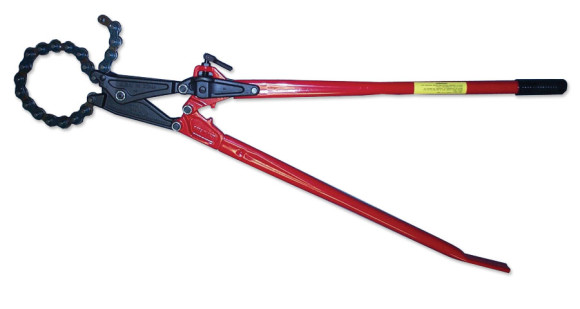
A pipe cutter, specifically the model above (Wheeler-Rex 590 Soil Pipe Cutter) is great for opening geodes. Simply score the geode around the perimeter lightly with a hammer and chisel, clamp the cutter around the perimeter of the geode, and then carefully apply pressure until the geode splits. It is most desirable to split geodes into two equal sized hemispheres.
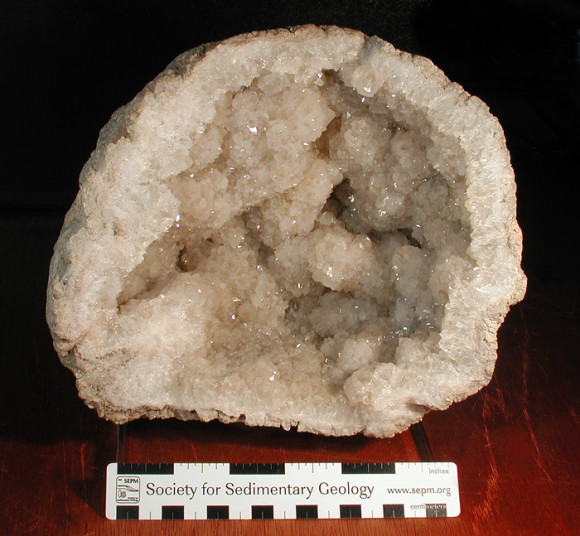
Large quartz geode from Keokuk area- 20 cm diameter. Collected by David Wixom. K. Nash specimen and photo.
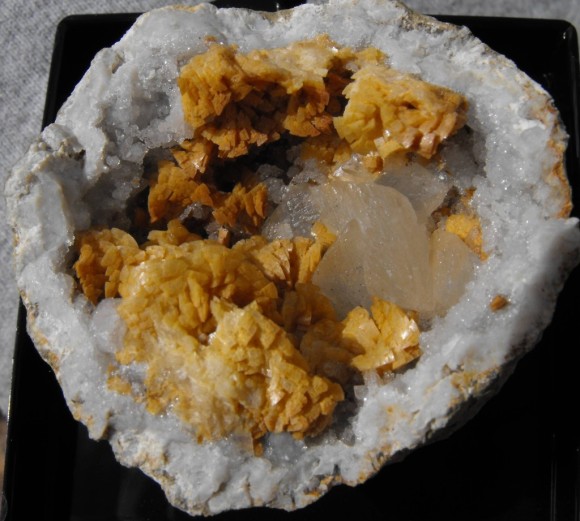
Typical geode and associated minerals (calcite and dolomite) from Keokuk, Iowa area. 4cm x 4cm. Rolf Lutcke specimen and photo. Ex. Paul Griswold
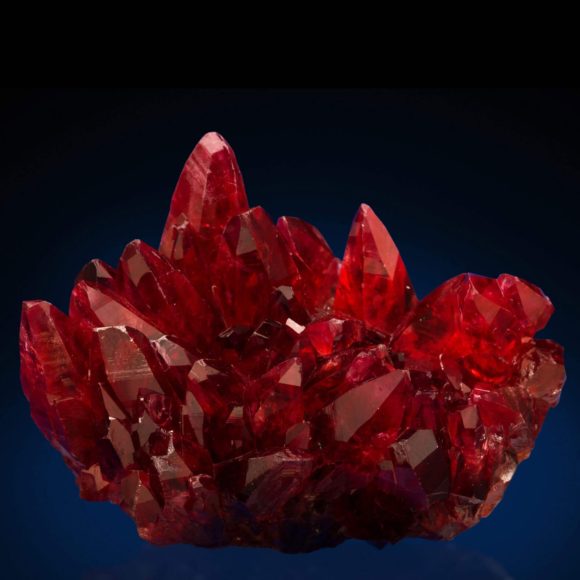
Geodes sometimes have carbonate minerals inside, like Calcite. But, wouldn’t it be cooler if they had crazy red Rhodochrosite crystals like this. Click here to see more amazing photos of crystals
Localities:
Sheffler Rock Shop and Geode Mine:
RR1 Box 171
Alexandria, MO 63430
At junction of Highway 61 and 27, 6mi S of Alexandria
Tim Sheffler
(660) 754 – 1134
tsheffler@mchsi.com
$25 per day for 50 lbs of material. 75 cents for each additional pound
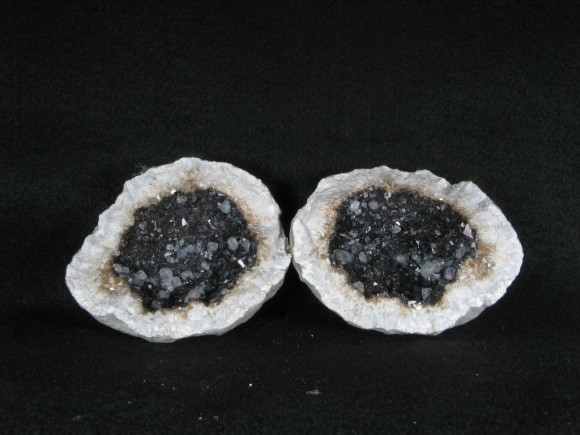
Calcite and quartz geode from the Sheffler Geode Mine. A good specimen for the locality. 10 cm wide. Roger Sedgwick specimen and photo. Collected by owner.
Geodes are very abundant at this locality, hence the high limit for material. They are typically filled with quartz crystals but some other interesting mineralization can be observed. Dolomite, calcite, and pyrite are common accessories. It is best to use a prybar to free the geodes from the limestone matrix and open them at home or wherever they can be carefully cleaned, opened, and sorted.
Des Moines River, Iowa and Missouri
Geodes can be found abundantly in the outcrops on the shores of the Des Moines river. Bring a shovel to loosen geodes from the muddy banks and wash them in the river so the surface features can be seen. Some rocks at these riverbank localities may be deceiving and look like geodes but are just cobbles that have been well-rounded by erosion. These geodes can be filled with a wide variety of minerals and be of extremely varying but most will only contain quartz and typically at most one other species such as calcite or dolomite.
Jacobs’ Geode Shop and Mine:
823 East County Rd 1220
Hamilton, IL 62341
(217) 847-3509
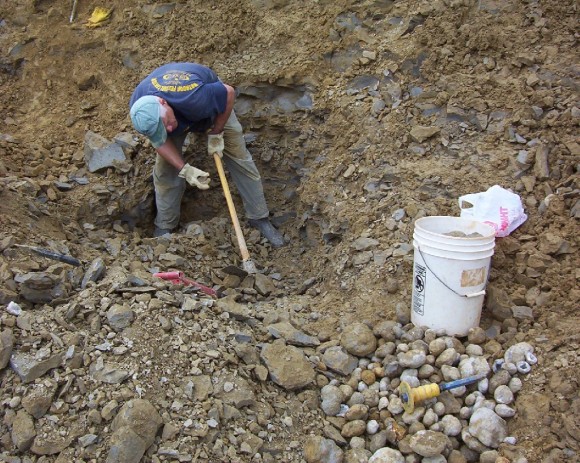
Caption: Collector with large pile of geodes in Jacobs’ Geode Mine workings. E. Harrington photo.
Call before visiting. It is best to dig while the owners are around so they can show you the best technique to use at this site. It’s a good idea to call in advance to make sure they will be at the mine. The all day fee is reported to be $20. Apparently the owners only allow visitors to crack certain geodes on site so most of the prep work should be done at home. Reported to produce very nice material
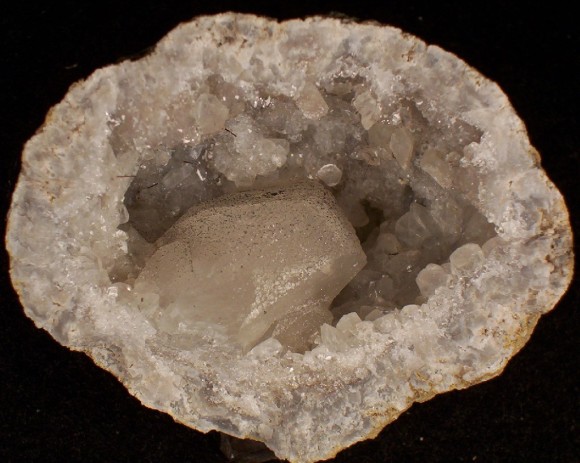
7cm geode with 3.5cm calcite crystal. E. Harrington specimen and photo.
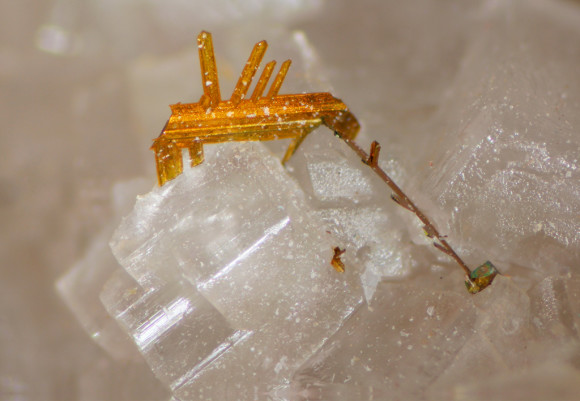
Marcasite crystal in geode. FOV 4.5mm. Collected and photographed by David Hanson.
Dennis Stevenson Geodes:
625 S. 18th St., Hamilton, Illinois
Call ahead to plan a trip: 309-337-3089 or 217-847-2952
$20 for one bucket, $15 for each additional one.
Mostly quartz based geodes, but some have nice calcite crystals as well. A staple Midwestern geode locality.
Find out what minerals Iowa is and has produced, check out what is new on eBay

Related posts:
Collecting Copper in Michigan’s Copper Country
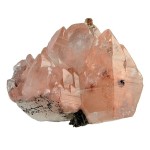
Field Trip: Copper Country Collecting in Michigan’s Keweenaw Peninsula
By Jeremy Zolan
Difficulty Level: Easy to Moderate
Supplies Needed:
Safety Goggles
Water
Sunscreen
Insect Repellant
Crack Hammer
Chisel
Shovel
Wrapping Paper for Specimens
Bucket
Sledgehammer (optional)
Prybar (optional)
Metal Detector (optional)
Description:
The Keweenaw Peninsula of Michigan has been nationally famous for over 100 years for its history of highly productive copper mining. The local basalt is criss-crossed with many thick veins of native copper that made up the main ore of many of the mines. Solid natural masses of copper weighing hundreds of pounds were found with relative frequency at the mines. Though these pieces certainly were the most valuable ore, the best specimens from the area are clusters of well formed copper crystals. Other metallic minerals can be found with the native copper such as silver, domeykite, mohawkite, and chalcocite. Many other interesting minerals like datolite, analcime, prehnite, agate, and thomsonite are also abundant in the Keweenaw Peninsula. While all the mines of the region are closed to copper production, many are maintained as museums and fee dig sites. There are also many abandoned mines in the area that can provide good digging in the dumps but be sure to acquire permission from landowners before visiting any location on private land.
Localities:
Central Mine:
US 41
Central, MI 49950
Map:
The large tailings piles of the Central Mine are visible from US 41 in Central, Michigan. Many collectors have had good luck recently working this location. Occasionally, contractors remove large quantities of tailings for construction purposes and this exposes fresh material. In addition to the standard copper specimens, copper included calcite and prehnite can be found here. Silver has also been found with copper here but it is rare. A metal detector is very helpful for sorting trough dump piles like those found at the Central Mine.
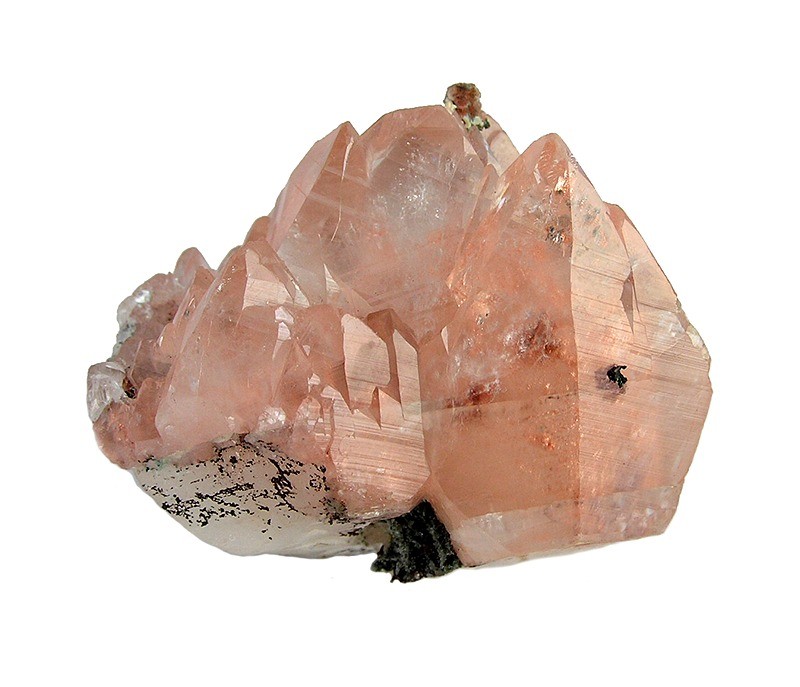
Caption: Calcite with copper inclusions. Central Mine, Central, MI 4.9 cm x 4.6 cm x 4 cm Ex. Rukin Jelks Rob Lavinsky Photo
Caption: Unusually large copper crystal. Central Mine, Central, MI. George Vaux collection at Bryn Mawr College. Scale bar is 1” long with rule at 1cm. Rock Currier Photo.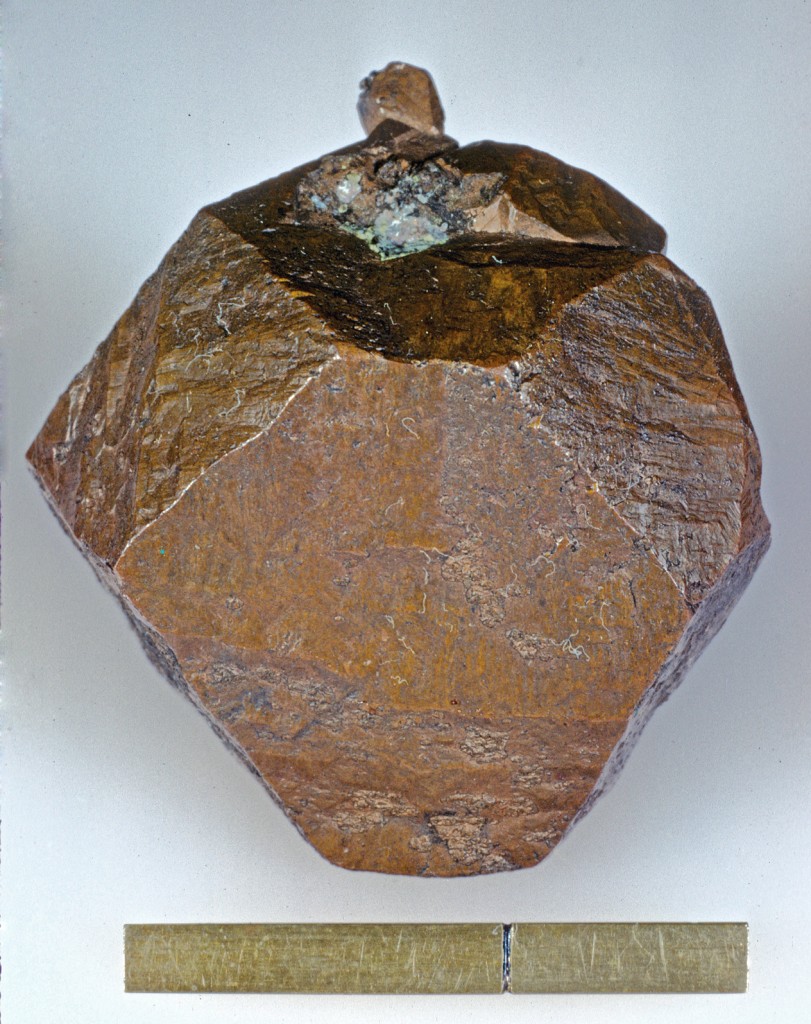
Caledonia Mine:
Website: http://www.caledoniamine.com/
906-370-1131
202 Ontonagon St,
Ontonagon
Michigan 49953
The Caledonia Mine is a fee dig site that requires an advance reservation. When digging at this site, collectors are given a large pile of stockpiled copper ore and tools to go through it. Weekly collecting events on Thursdays and Saturdays are also held from the first Thursday in June to the last Saturday in August on the ore pile. Advance reservations are needed for these too. The workings of the Caledonia Mine are impressively preserved and tours are offered too. The mine tours aren’t necessarily just geared for casual guests. Many kinds of tours are offered, some with a very in depth historical or scientific focus. It is best to check the museum calendar to see if any events are happening during the time of your visit.
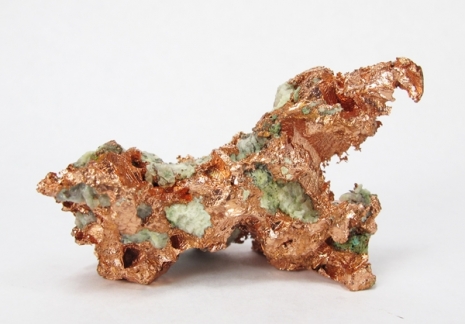
Caption: Representative specimen of native copper from the Caledonia Mine’s recent workings. 5.6cm wide. Rob Lavinsky Photo
A.E. Seaman Mineral Museum
Website: http://www.museum.mtu.edu/
Michigan Technological University
1404 E. Sharon Avenue
Houghton, Michigan 49931-1295
E-mail: tjb@mtu.edu
Telephone: (906) 487-2572
Michigan Tech’s A.E. Seaman Mineral museum is among the finest mineralogical museums in the world. Its laboratories are also critical in performing much of the cutting edge mineral research currently being performed. During the period of most intense copper mining in Michigan, many specimens of local minerals were donated to the museum. Their collection of Michigan minerals is the finest in the world and there is a strong local emphasis on their displays.
Check out our custom search and view all the minerals from Michigan for sale on eBay. Not only will you see lots of neat stuff for sale, you’ll also get an idea of what localities are producing in the region.

Related posts:
Cascade Canyon Ruby Crystals – A Los Angeles Hidden Gem
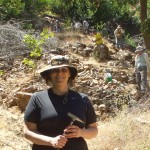
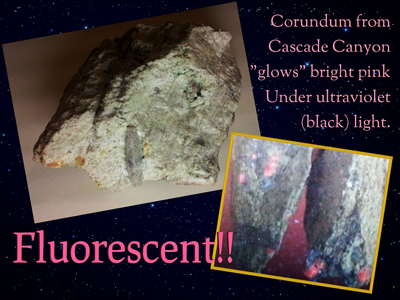
Cascade Canyon, located exactly 1.7 miles southwest of Mt. Baldy, is the home to many interesting, if small, minerals and veins of interesting polishable minerals. Collecting around the top and bottom of the canyon, we have found various qualities and sizes of corundum var. ruby along with small veins of beautiful, if hard to come by, pieces of lapis. In addition, we have found minerals that the area is not well known for, including small dravite crystals, epidote, diopside and uv reactive calcite.
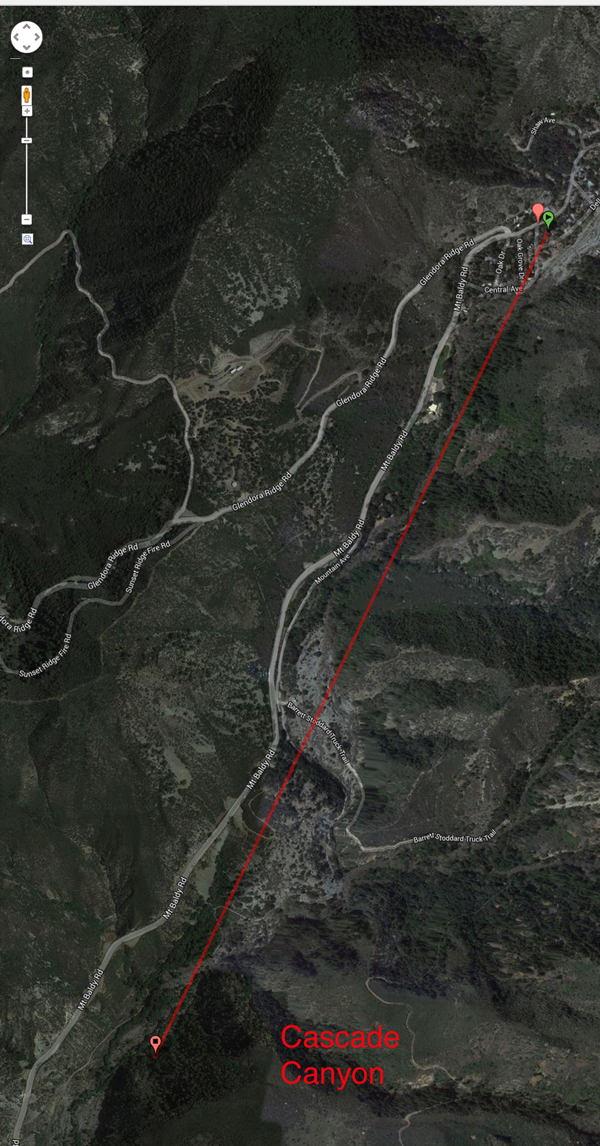
The lapis deposit is near the top of the mountain, with no access that would be considered even reasonably obtainable by anyone who is not well versed in mountain climbing. In addition, the area of the deposit was covered in an avalanche years ago. Anyone attempting to reach this deposit would be doing so at risk of life itself. In the upper streams of cascade canyon, before it turns into what would be impassible for most, bits and pieces of lapis can be found. Most people we have interviewed who have collected there in the past are happy with one visit to the location.
On Barrett-Stoddard Road, though closed to vehicle traffic, you can find interesting mineralization along the roadside, which is now a popular hiking/biking trail. Calcite veins with Diopside crystals have been located, however, the diopside is not crystallized well, with a melted appearance. The corundum locations along the roadside give the viewer a understanding that the deposit of “ruby” stretches along the entire mountainside.
Along the bottom of the canyon, on the south side of cascade canyon, along the area where the mountain follows the river on the lip of the eastern mountainside. While boulders of ruby bearing matrix can be found EVERYWHERE along the mountainside, the most popular collecting location is a small canyon that dumped out the contents of several rockslides into the valley below, creating a field rich with broken chunks of rocks with small ruby crystals inside.
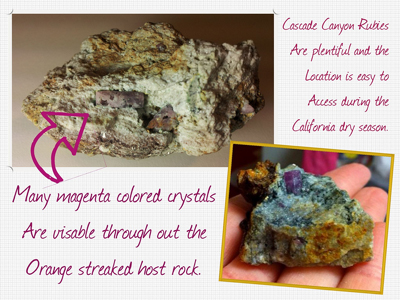
We were delighted to read Natalie Weisiger’s article about her trip to Cascade Canyon with the Gem and Mineral Council of the Los Angeles Natural History Museum. You can read about it, right here at http://omigems.com/blog/2013/07/california-corundum-from-the-ground-to-my-finger/ It is very interesting to read about the California ruby coming from the ground and into a piece of jewelry. You can certainly believe that is one unique piece of jewelry!
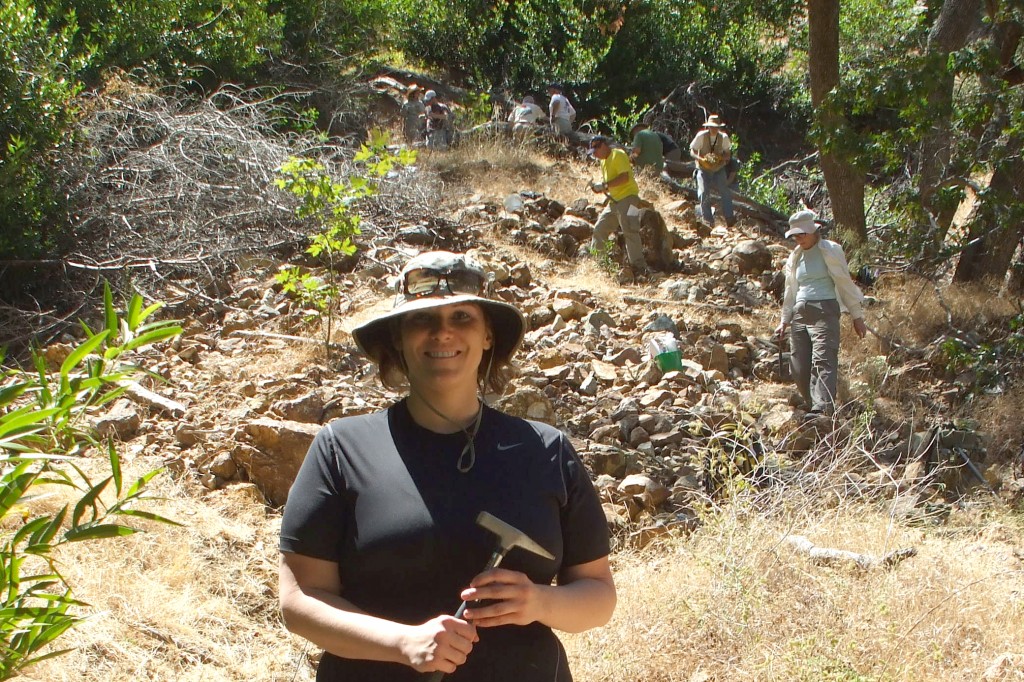
Natalie Weisiger in front of the landslide pile of ruby bearing rocks on the south side of Cascade Canyon
Related posts:
Fossil shells replaced by calcite found in the roads of Central Texas
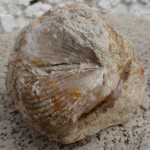
The Central Texas counties surrounding Limestone County are full of beautiful ancient marine shells replaced by calcite, both massive and crystallized. Luckily for the collectors of minerals and fossils, hundreds of miles of low traffic roads in Central Texas contain a wide variety of ancient sea life replaced by calcium carbonate. They are up on the surface of gravel and dirt roads, as snowy white gravel, stretching down the country lanes.
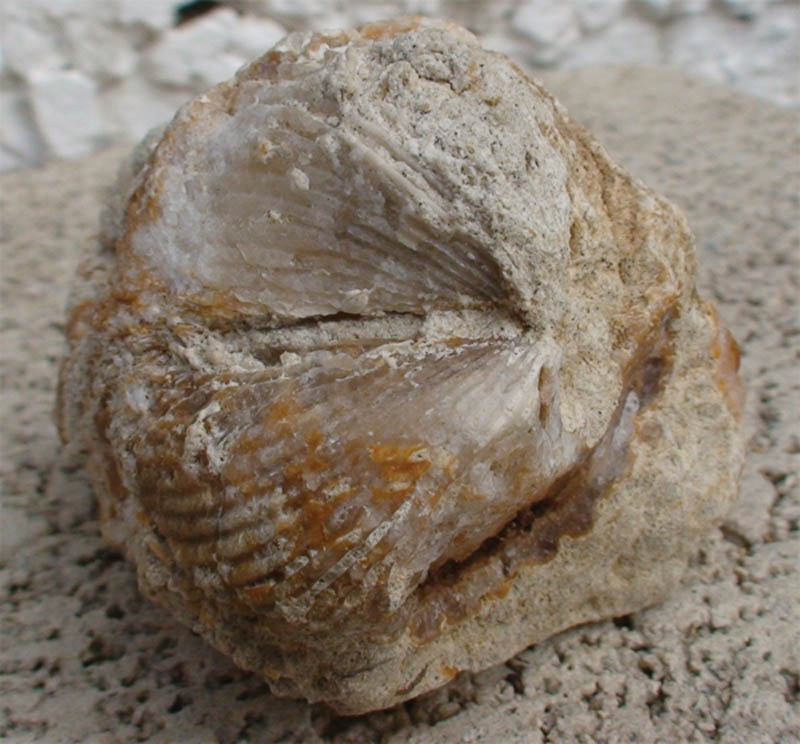

This area of collecting is centrally located between Interstate 35 and 45. Those highways run through Texas, connecting San Antonio, Austin, Houston and Dallas. In between this area, vast deposits of limestone of a very high quality are found and mined for agricultural and industrial use. It is often found as crushed aggregate used to cover the stone roads of back country Texas. Spiraling out of the central texas area like a web connecting new developments with well maintained farm routes, the white roads of Texas are often found to contain calcite crystals and calcite replaced marine shell fossils. Clams, Brachiopods, Turritella, Ammonites and other interesting shells are found, often with cores and voids filled with crystals of calcite.
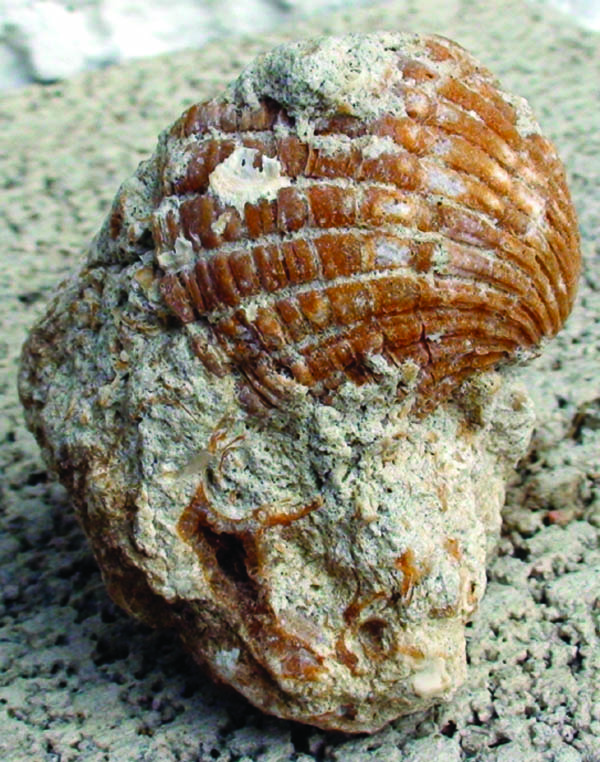
Getting to a collecting location is simple! Simply pull up Google Maps and take a look at a satellite view of Central Texas. As you get closer, look out for maintained county roads, which you will see, are bright white. This white color is caused by this limestone gravel. Make a note of these roads to inspect and take a trip to Marlin, Mart, Rosebud, Franklin, Calvert, Madisonville, and Crockett. Since there is ample loose gravel, do not DIG into the road or bother to take tools with you. Loose Gravel. Mostly made up of calcite replaced shells. What an amazing collecting experience. Simply opening your car door will result in you finding a loose fossil. With smartphones, androids and iphones, simply using google maps while navigating will be all you need for a spur of the moment collecting trip. This area is a little over 3 hours from San Antonio, a quick 2 hours from Austin, Houston and Dallas. It is a PERFECT field trip in all weather besides tornadoes and snow!
